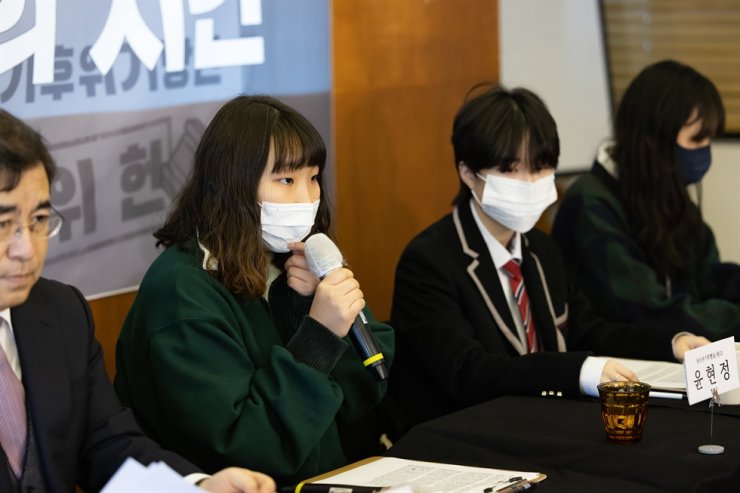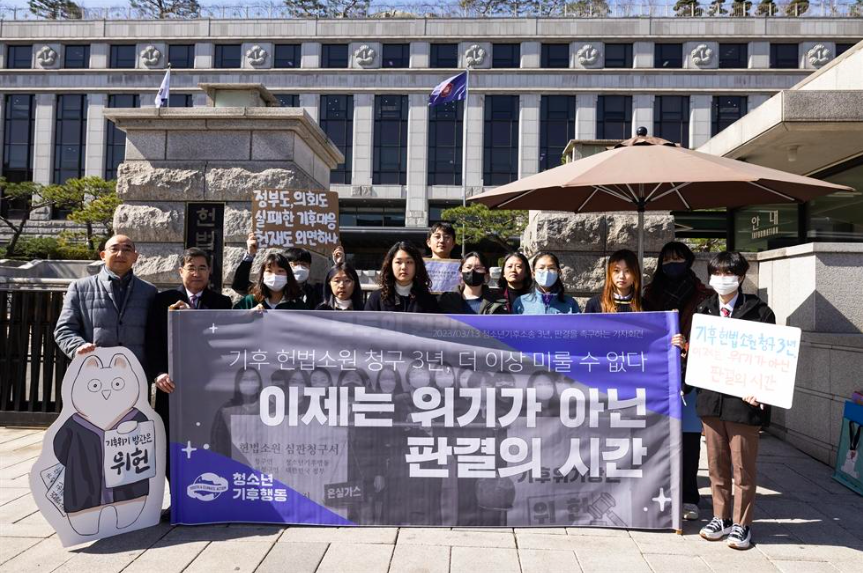Casebook Info
In East Asia’s first youth-led climate case ever, 19 young activists are taking the South Korean government to court for failing to reduce GHG emissions sufficiently. The move reflects a growing global youth climate movement and an increasing effort to hold states accountable for empty climate promises. Plaintiffs challenge South Korea’s failure to undertake life-saving emissions mitigation. They point to the fatal risks posed by climate change and the crisis’ disproportionate impact on younger generations.
- Year Filed 2020
- Year of Most Recent Ruling N/A
- Year of Final Ruling N/A
- Jurisdiction South Korea
- Court Name South Korean Constitutional Court
- Primary Focus Adaptation & mitigation
- Ruling On N/A
- Plaintiff(s) 19 youth
- Respondent(s) Government of South Korea (National Assembly and President)
- Outcome Solutions for Our Climate (SFOC)
- Organizational leader of the litigation N/A
Background
Drawing on an increasingly robust body of precedents from around the world, Plaintiff Kim Yujin and 18 other youth activists from South Korea sued their government in March 2020 for failing to protect and preserve their fundamental rights.
The 19 youth plaintiffs, all part of the Korean Youth 4 Climate Action Group (“Y4CA”), allege that a 2019 parliamentary revision to the state’s Framework Act on Low Carbon, Green Growth unconstitutionally infringes upon their rights by failing to set adequately ambitious emissions reduction targets. The amended Act pledged to reduce annual domestic GHG emissions to 536 million tons by 2030. If successful, this decrease would represent a drop of 24.4% drop from 2017.
In 2020, President Moon Jae-in of South Korea called the nationally determined contribution (“NDC”) set pursuant to the Paris Agreement a “very challenging target” and told one committee meeting, “This is the most ambitious reduction target possible under our circumstances.”
Nevertheless, it’s not enough, argues Yujin and Y4CA. The plaintiffs contend that the Act’s proscribed emissions targets are far from sufficient, since they are significantly below the emission reductions required to keep global warming well below 2°C degrees – the target established by the Paris Agreement and agreed to by 200+ countries, including South Korea.
The Y4CA youth point out that even if the current Act’s emissions targets are met by 2030, global temperatures will still stand to rise by 3°C degrees or more by the mid-to-late 21st century. In short: more needs to be done.
“The truth is that South Korea’s emissions are not falling fast enough, and this is definitely not the best effort the government could be making to save our future,” said Yujin in 2020. “Many say we are too cynical or idealistic, but we will not accept lousy excuses when the entire world as we know it is on the line.”
The plaintiffs argue that the government is violating their constitutional rights to a healthy and pleasant environment (Article 35(1)); to life and the pursuit of happiness (Article 10); and to “the right to resist against human extinction,” which plaintiffs argue is enshrined by Article 10. They also contest intergenerational inequalities as an infringement of the constitutional prohibition on discrimination (Article 11) and invoke the duty of the state under Article 34(2) to prevent environmental disasters.
Notably, the plaintiffs aren’t asking that South Korea’s government create and pass new climate emissions policies. Instead, they’re asking the Constitutional Court to rule on the question of whether the state’s mitigation actions thus far have sufficiently protected and preserved the plaintiffs’ basic rights. Or, put another way, the question is whether the state’s inadequate climate plans violate their rights.
The plaintiffs have also filed a number of supplemental complaints and briefs since the submission of their original complaint over 3 years ago, including materials on scientific evidence, the sufficiency of South Korea’s response, the need for a prompt hearing, and updates regarding similar developments in litigation in other countries (for example, Friends of the Irish Environment v. Ireland, 2020).

In their first Supplemental Brief (September 2020), the plaintiffs provided updated information regarding contemporaneous and severe climate impacts in South Korea. In their second supplemental brief (January 2021), they advanced arguments detailing the government’s violation of its obligation to protect citizens from the harms of climate change. This “obligation to respond to climate change,” petitioners contend, derives from the right to a healthy environment and the constitutional obligations to prevent disasters and protect health and safety.
No further action has been taken on the case, which at present remains pending before the Constitutional Court in Seoul.
- 8,000 the number of homes lost during South Korea’s 2020 monsoon season, the longest such season in the country’s history
- 536 million tons the amount of carbon emissions South Korea aims to reach by 2030, a number Plaintiffs argue remains far too high
- Article 10 of South Korea’s Constitution, which the plaintiffs say includes “the right to resist against human extinction.”
- 3.2°C the predicted average temperature increase when the global greenhouse gas reduction targets, including South Korea’s greenhouse gas reduction goals, are realized (cited in the plaintiffs’ Supplemental Brief, at 37)
- 3.3 billion tons the nation’s predicted 2060s water deficit as a result of climate change (cited in the plaintiffs’ Supplemental Brief, at 41)
Strategies
Focusing on youth and future generations

The particular vulnerability of younger populations to the effects of climate change is central to the plaintiffs’ case. Invoking their constitutional right to be free from discrimination, the plaintiffs argue that insufficient climate mitigation places a disproportionate burden on younger generations.
Tying countries’ / corporations’ climate and human rights obligations to international climate and environmental law, including, for example, the temperature target established by the Paris Agreement

To demonstrate the insufficiency of their government’s emissions target, the plaintiffs invoke the Paris Agreement’s benchmark goal of limiting global warming to well below 2°C degrees. Pointing to this temperature goal, they argue that South Korea’s domestic emissions targets are inconsistent with the government’s obligation to limit global warming because they surpass the state’s nationally determined contribution (NDC) and will not suffice to achieve the Paris Agreement’s goal.
Take-aways
Even where disputes are slow to reach a decision on the merits, cases can still impact policymaking and “soft law” spheres.
Following the plaintiffs’ filing of this case, in December 2022, the Korean National Human Rights Commission (“KHRC”) issued a statement to President Moon Jae-in confirming that the climate crisis has “far-reaching impacts on multiple human rights, including the rights to life, food, health and housing” and that the government has a fundamental obligation to prevent global warming. More recently, in June 2023, the Commission announced its opposition to South Korea’s Carbon Neutrality Act (2021) and its decision to submit an opinion on the matter to South Korea’s Constitutional Court. Arguing that the emissions reduction targets included therein remain too low, the KHRC has challenged the Act as unconstitutional and in violation of the fundamental rights of future generations.
Impacts
Rulings on constitutional complaints such as this are binding on all South Korean state agencies and local governments. If successful, this case’s outcome could closely reflect that of the Urgenda decision, whereby the state is constitutionally mandated to bring emissions reduction targets in line with the Paris Agreement and/or additional benchmarks, depending upon the court’s ruling on questions of intergenerational inequity and burden-sharing.

